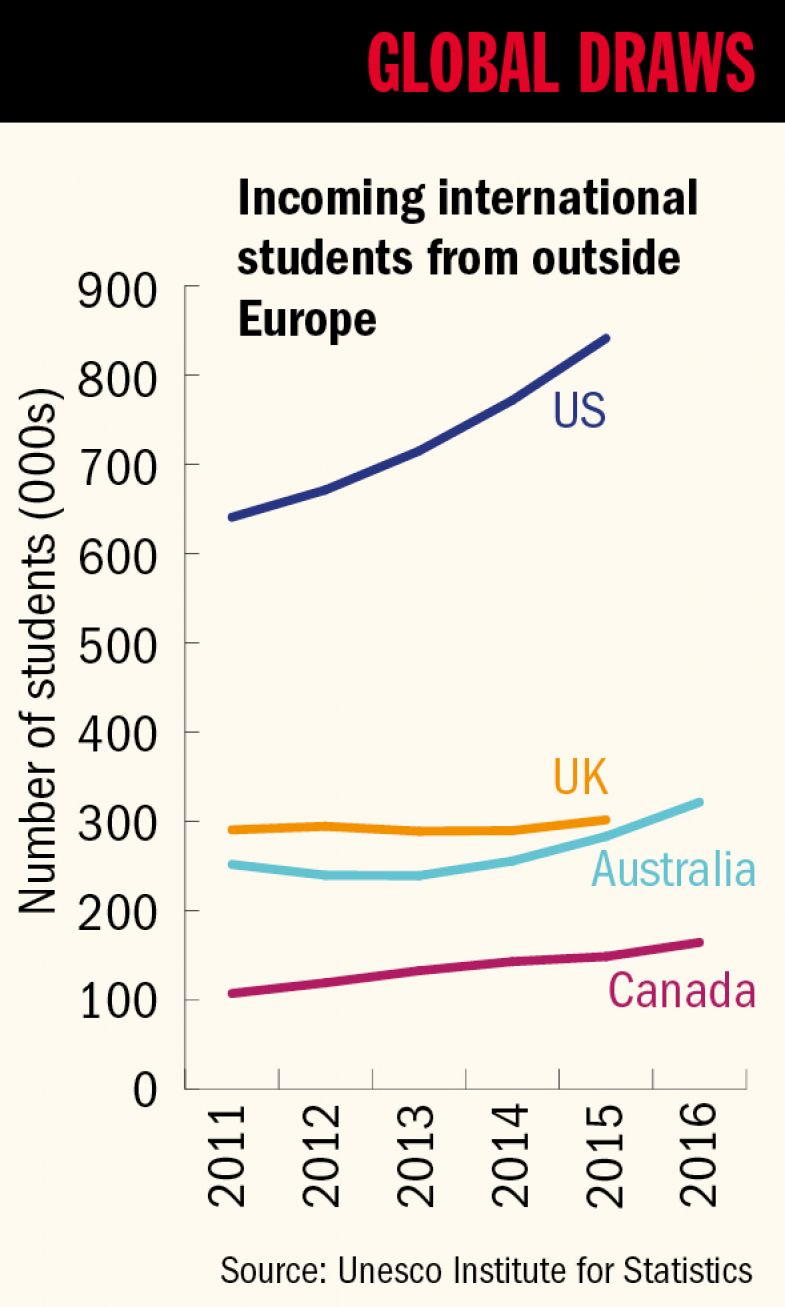Australia is poised to overtake the UK as the second most popular global destination for international students, according to a new analysis.
The research, based on international student enrolment figures from across the world, says that it is likely that Australia has already outstripped the UK in terms of the number of overseas students from outside Europe and suggests that the UK’s position as the top destination for continental European students is “about to be decimated by Brexit”.
The result, it concludes, is that “Australia may have surpassed the UK in 2018” in terms of total international student numbers in higher education, and “if not will almost certainly do so in 2019”.
The US is comfortably the top destination for international students.
The paper, “The UK in the global student market: second place for how much longer?”, from Simon Marginson, director of the Centre for Global Higher Education at UCL, was published on 19 July and draws on data from the United Nations Educational, Scientific and Cultural Organisation and the UK’s Higher Education Statistics Agency.
Unesco figures on incoming international students from all parts of the world appear to show that the UK was comfortably ahead of Australia in 2015 (the most recent year for which it has data) with 431,000 overseas students, compared with 294,000 in the Antipodean nation.
However, examining the data over time shows that the gap between the two countries has narrowed substantially, with international student numbers growing by just 2.6 per cent between 2011 and 2015 in the UK and by 12.1 per cent in Australia over the same period.
National data obtained by Times Higher Education, which report slightly different figures, suggest that these rates of growth have continued in 2016. There were 442,000 non-UK students in the UK in 2016-17, according to Hesa, and 391,000 overseas students in Australia in 2016, according to the country’s Department of Education and Training.
The paper adds that, according to government figures, in 2017 the number of international students in Australia climbed by 14.7 per cent and that high growth continued into 2018.
Professor Marginson blamed the UK’s waning appeal to non-European Union international students on the government “running a post-study work visa regime that is much less attractive than that on offer in Canada, Australia and, until recently, the US”.
“It is this, not Brexit, which will ensure that the UK moves down to number three in the global student market in 2018 or 2019. Later, however, Brexit will compound the decline in the UK’s global position by driving UK numbers down,” he said.
Professor Marginson added that if EU students are charged international student fees post-Brexit, “then it is impossible to imagine anything other than a substantial overall drop in EU students entering the UK, and that will erode the UK’s already declining global market share”.
“There will no longer be a strong UK performance in Europe to mask the deteriorating UK position in the rest of the world,” he said.
While Professor Marginson noted that “all reports from Australia indicate continuing high growth” in overseas students in 2018, he acknowledged that it was “almost certain” that rapid growth in the number of students from China would “slow”.
“Following Australia-China tensions, and criticism of China in the Australian media – including some claims that Chinese students threaten Australia’s national security – the Chinese ministry has made successive website announcements that Australia is not a safe place for students from China. It looks almost certain that education agents and parents/students will respond by shifting at least some of the traffic from Australia to North America,” he said.

Philip Altbach, research professor and founding director of the Center for International Higher Education at Boston College, said that he was “not surprised” to see “how well the Australians are doing” in overseas student recruitment.
“They’re very aggressive – they see international students as a major income source,” he said.
“The things that are working against increasing numbers for the UK [include] not just Brexit, which I think is the main driving force, but also real restrictions on granting visas and the general terms and conditions, especially on working in the country after finishing studies,” he added.
However, Professor Altbach said that it was important to note that there was generally “significant instability in international student numbers”, which made long-term trends hard to predict.
Michael Peak, head of higher education systems research at the British Council, said that while the overseas student number gap between the UK and Australia was “narrowing”, the latest visa data show that key sending countries to the UK are “strengthening or renewing their interest in studying in the UK”. For instance, the number of granted student visas from India grew by 68 per cent between the first quarter of 2017 and the first quarter of 2018, he said.
后记
Print headline: Australia on track to overtake UK in global student race




